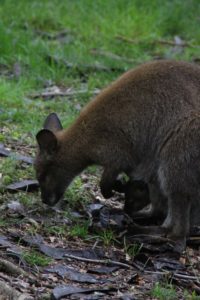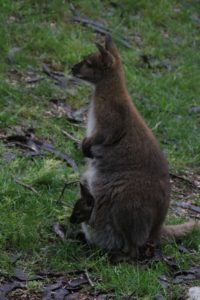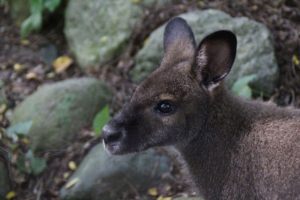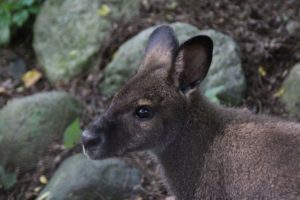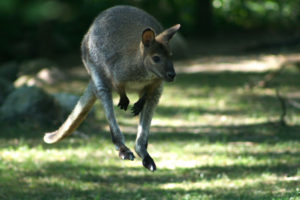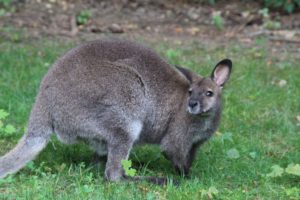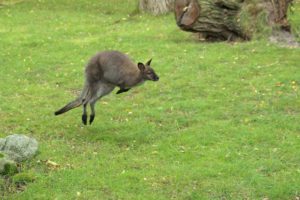BENNETT'S WALLABYMacropus rufogriseus
Conservation Status: Low Risk / Least Concern
They have a wide distribution, can occupy a large range of habitats, and do not have many predators.

Learn More
Color:
The Bennett’s wallaby is dark grey in color with a neck that may appear more brown. Like other members of the Macropodidae family, they have large ears, a long, tapering tail, and hind limbs that are stronger than their forelimbs. They have syndactyly (fusing of digits) of their second and third toes, which is covered by skin and has only one claw.
Size:
2.3-3 ft. tall (males) and 2.2-2.4 ft. tall (females). The tail length is about the same size as the head and body length.
Weight:
15-26.8 kg for males and 11-15.5 kg for females
Average Lifespan:
10-15 years
Captive Lifespan:
Up to 15 years
The Bennett’s wallaby is native to Australia; however, it was released into New Zealand where it has been rather successful. In particular, it is found throughout the southeastern part of Australia and is also present in Tasmania, King Island, and the Furneaux Group.
They prefer eucalypt forests where there is a shrub understory. For grazing, there is usually an open area close by and they may be seen in agricultural areas,
Mating:
In Tasmania, they breed seasonally, but the Bennett’s wallaby breeds year round on the mainland.
Gestation/Incubation:
33 days
Litter/Clutch Size:
1 Joey. When born, the young are highly underdeveloped and must climb from the cloaca into the pouch and latch onto a teat, which then swells in the mouth to allow them to remain in place.
Mature:
A joey will leave the pouch around 9 months and females reach sexual maturity around 14 months while males reach maturity around 19 months.
They are primarily grazers but may also be browsers, feeding on grasses and other plants. Grasses compose about 74% of their diet. The Bennett’s wallaby may prefer grasses that have seed heads on them.
They have a linear dominance hierarchy; however, they tend to be solitary and will interact with the same individuals. The wallabies will be more active in the morning and late afternoon, often resting midday. Males will disperse after reaching 2 years of age, but females will stay in the same range as their mothers.
1. Body weight tends to correlate with dominance.
2. They have embryonic diapause in which the embryo delays implantation in the uterus. This is in part influenced by the amount of light available at that time of year (they delay birth until it gets warmer). Another factor is the presence of a joey still in the pouch.
3. They have a pentapedal motion when moving slowly and a bipedal hopping for quick movements.
4. The Bennett’s wallaby does not have well developed vocal cords, but can growl and hiss.
5. They consume roots during droughts to obtain water.
6. They can produce 2 kinds of milk. One high in fat for the joey in the pouch and one lower in fat for the joey leaving the pouch.

